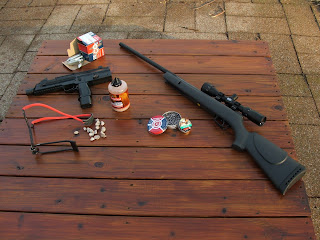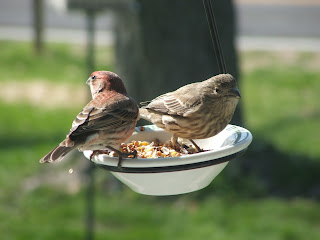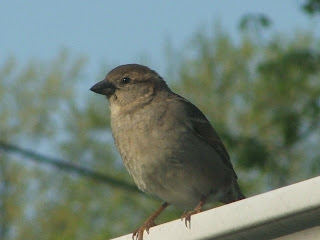 |
| This photo, by wikipedia, is of a mass flock in England. They can get this big....and bigger, in th U.S. too! |
Hunting European Starlings and other Non-native, unprotected species, Birdwatching and nature photography.
Thursday, December 23, 2010
Starlings as year-round hunting skills sharpeners!
While reading up about the causes of the extinction of Passenger Pigeons, one of the causes stated, was that they provided a challenging target, flying up to 60 mph. How about we turn this type of challenge into a better purpose with Starlings! They can fly at speeds of about 55 mph, and often travel in immense flocks, like the Pigeons used to. Hunters who might hunt Mourning Doves in their season should tatally try the challenge of the Starling, available year-round, as a great way to hone in their shotgun skills!
As a quick side track, people from other countries could most prabably also participate in Starling Hunting, seeing the birds a pest most everywhere it appears!!
Wednesday, December 22, 2010
Missed big flock!
A giant flock of Starlings settled in the field in front of us, but when they finally flew a little into our yard, the first shot scared them off. After that, I attempted a few potshots at airborne birds, but to no avail. I'll be ready next time!! Other than those birds, the two wanted species have been keeping clear in the colder weather.
The cookie-making at the Burns' went well, and us boys got through about 1 and 1/2 rounds of Axis & Allies! We also sang a few christmas carols, and played some foosball.
Macroeconomics isn't so bad once you start getting into it.
You really need to listen to Baba Yetu at the bottom of this blog! It's The Lords Prayer in Swahili, sung by the Soweto Gospel Choir. Another version of the song can be found on Christopher Tin's CD, Calling All Dawns.
You really need to read "Hancock the Superb's" Short Story (blogs I follow section).
The cookie-making at the Burns' went well, and us boys got through about 1 and 1/2 rounds of Axis & Allies! We also sang a few christmas carols, and played some foosball.
Macroeconomics isn't so bad once you start getting into it.
You really need to listen to Baba Yetu at the bottom of this blog! It's The Lords Prayer in Swahili, sung by the Soweto Gospel Choir. Another version of the song can be found on Christopher Tin's CD, Calling All Dawns.
You really need to read "Hancock the Superb's" Short Story (blogs I follow section).
Monday, December 20, 2010
My Goal; Make it Yours!
So, in all this, what is the main purpose I'm trying to work towards? Rashly speaking, I would love to able to take Starlings and H. Sparrows and R. Doves out of where they have invaded, along with any other problematic species worldwide, but more realistically, I'm mainly focusing on ridding at least Missouri of our huge populations of these birds. In this way, these places will become a little closer to what God created them to be like in the beginning. In the long run, in the (God-willing, near) future, I would like to start a "club" of starling hunters like myself, and every month or so, I'll post the results of our gathered efforts with a grid showing the numbers of birds killed, and by whom they were eliminated.
Thursday, December 16, 2010
Success!!
Phew!! I just squeezed pass with a score of 54! That's my second to lowest score yet, (the lowest being for U.S. History II, with 53) but at least I passed and now have 24 college credits! Thanks to anyone who did pray for me (I know my family was), and I hope for his blessing on the next test in Macroeconomics (its seeming as overwhelming as it looks right now!). By the way, if you go to Mazzou's Merry Memories, you can find more about the ball I was talking about before.
Wednesday, December 15, 2010
Studying hard!
Wow! What a busy week!
I can assure you that I did not have any spare time for shooting Starlings in the morning these past few days, and my studies for Western Civ. II are coming to a climax. I'm supposed to be taking the CLEP tomorrow! Other than that we were also preparing for the annual CHEF Christmas Ball, which happened on the 11th, I had a dentist and optometrist appointment, and we are going to our friends, the Burns (the producers of Pendragon) this Friday with 2 other families to make cookies.
Pray for me (and my brain) tomorrow for my upcoming test!
SAM
I can assure you that I did not have any spare time for shooting Starlings in the morning these past few days, and my studies for Western Civ. II are coming to a climax. I'm supposed to be taking the CLEP tomorrow! Other than that we were also preparing for the annual CHEF Christmas Ball, which happened on the 11th, I had a dentist and optometrist appointment, and we are going to our friends, the Burns (the producers of Pendragon) this Friday with 2 other families to make cookies.
Pray for me (and my brain) tomorrow for my upcoming test!
SAM
Wednesday, December 8, 2010
What I use: Traps
Enyone can use traps to eradicate Starlings. I am currently using 3 types: a nestbox type (my own adaptation from a squirrel box trap), strategic use of mouse traps, primarily for House Sparrows, and a new invention, the "Electric Birdbath"!. Ordinary nest boxes can also serve as "traps", if stalked up on at night. I used to use a cage trap which was operated by a string from under the feeder to the vent hole in my window. This was quite effective, as you can catch as many birds as enter the cage!
 |
| Nest box type trap (for complete instructions, post or e-mail me) |
 |
| Bottom door to remove birds (I put a plastic bag around the opening, so the bird won,t escape) | <><>
 |
| Front view: door runners to keep it in line & stopper underneath (box trap) |
 |
| Place mouse traps in strategical spots where only H. Sparrows go, like under a car in your drive way (shown)... |
 |
| ...or on the side of the hous, if you havn't noticed other birdsd come this close. |
 |
| "The Electric Birdbath" (the bird sits on the ring, drinks out of the bowl, I plug it in, and, Bang!, no more bad bird! (not tried out yet, not right season. Don,t ever leave this one plugged in!!) |
 |
| Use this simple sharpened nail to kill unwanted birds, if you don't have an airsoft or BB gun. |
 |
| Give a quick jab in the circled are, where the lungs are situated. (birds live suffer lomger without their heads than without their lungs!) |


Friday, December 3, 2010
What I use: Weapons
Among the many different options of weapons for Starling control, the air rifle is a must! I now have a Gamo Bigcat 1200. This company, Gamo, is my favorite as they really seem committed to their cause. For example, they test every batch of airgun pellets produced by firing a random selection about 20-30 yds. away. If the grouping is outside of a 1 3/4 clump, the whole batch is remelted. Also find how they put air rifles to the test and see some amazing airgun hunts at Gamo USA. Its hard to beleive how a .177 cal. pellet can take down a wild boar in a single shot!
 |
| Here are my weapons! |
 |
| Gamo Big Cat fitted with Burris 3-7 X 50 air rifle scope. (Big Cat uses 177. cal. pellets, and shoots at 1000 fps. with ordinary pellets, and 1200 with PBA pellets, which are exclusive from Gamo) |
 |
| View through the scope |
 |
| Crossman Pellets: Although Crossman is a good make, I have noticed less accuracy. Go with Gamo! |
 |
| Umarex Steel Storm 420, uses 177. caliber BB's, shooting them at 430 fps. |
 |
| The Steel Storm has a 30 round magazine (shown), and a 300 round resevoir! |
 |
| Standard sights on the Steel Storm |
I also sometimes use a slingshot, shown under the Steel Storm in the big photo, but I don't get to use it often, because of the others weapons superior power and accuracy. I use approximately marble sized rocks.
Saturday, November 27, 2010
Look-alikes of the House Sparrow
These little guys are also natives of Europe, but just by looking at their innocent expressions, you can tell they never do much damage, and they're also protected. One way to tell the Eurasian Tree Sparrow from the male H. Sparrow is its smaller size (H. Sparrow = 5 1/4", E.T. Sparrow = 5"). Both the House Finch female and the E.Tree Sparrow are slimmer than the House Sparrow, except in desert regions, where it has adapted more efficiently to a slimmer size. Other diferences are marked under the photos.
Here's a plump-looking specimen, fluffed up 'cause of the colder weather: note finer bill, absence of black bib, but black mask like H. Sparrow male. Same abcense of wing bars as above photo
 |
| Typical slim adult Eurasian Tree Sparrow: note brown cap, black cheek spot, absence of wide wing bar. |
Illustrating the obvious innocence of these little ones: not cute expression!
 |
| Adult female House Finch: Though the bill is the same size as female H. Sparrows, note belly streaks and lack of eye stripe |
Both male and female House Sparrows: note females faint wing bars like female H. Sparrows
House Sparrows
Rules and regulations (you can't get away from them!)
Although Starlings and House Sparrows are not protected nationwide, specific states and counties have their own book of rules, so its always a good idea to review these first! As I mentioned earlier, Rock Doves (Pigeons) are protected in a few states. If you are allowed to shoot on your property, there are most probably some rules on this too, such as a minimum of an acre of land etc. In my case, we have 3/4 of an acre, but our neighbors have a full acre, and allow our family to use their property, so I'm o.k. on this end. According to a man I talked to from the MO Department of Conservation, you can hunt on public hunting property in MO, but need a hunting license to do so, and must follow specific rules of the property. Also according to him, a license is not required for public land that you have permission to use. Any one can trap these birds on their own, as well as permissioned property, and I'll have photos later on of what traps I use.
Thursday, November 25, 2010
An Introduction to Starling Hunting
Thanksgiving is a great time for me to introduce to you to a more possible subject to pursue than the Turkey,....the European Starling! (Sorry, you can't eat this type). This bird was introduced to the U.S. in 1890 by a group of Shakespeare fanatics in New York, (the Acclimation Society of North America) whose main idea was to have all the birds present in his plays also present in North America. As you guessed, Shakespeare just happened to mention a Sturnus Vulgaris (latin name for our bird) in a play, and Eugene Schiefflen, one of ASNA's members, released 60 birds in N.Y.s Central Park in '90, and again in '91. Looking for decendants of these guys shouldn't be too difficult to find, as N.A.'s Starling population is estimated at over 200 millon birds! This fast spread is due to the fact that they are very agressive, hardy birds, adapting to habitats like cities to deserts. Their beaks design allows them to pry open hard nuts and seeds to survive harsh winters. Some of the problems they cause include: Ruining over $800 million in crop damage, competing with native birds for nesting cavities, and spreading diseases through their droppings that they are immune to. The good thing about this disturbing news is that the Migratory Bird Treaty Act does not protect this species, and a permit is not needed to hunt them on private property. Another invasive Species, the House Sparrow, also a species sponsered by Eugene, is not protected. This little guy causes problems similar to the Starlings. It was introduced from Europe to keep down problem bugs, but it took only a few years to show how much the bird turned the tables. Rock doves from Europe are not protected in some states, including here in Missouri. They are mostly a nuisance in cities, where they nest and roost on buildings. The Photos above are both Starlings. The shape in flight can be easy to recognize. The other is one in full summer plumage (in winter, they become a duller brown, and the bill is grey instead of yellow).
Subscribe to:
Comments (Atom)













